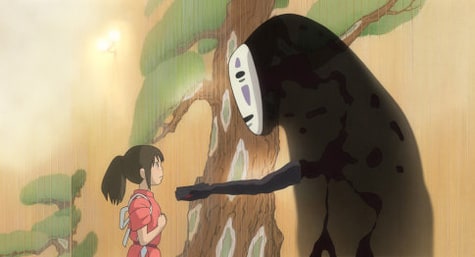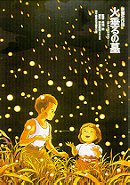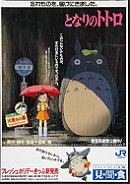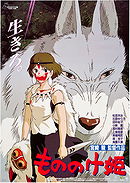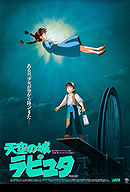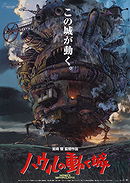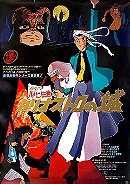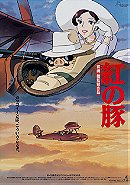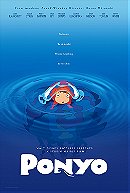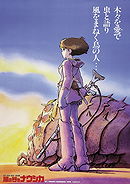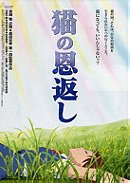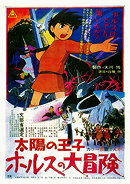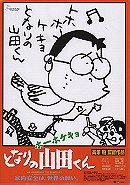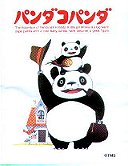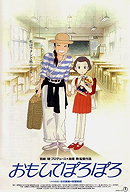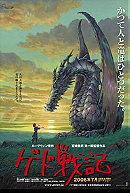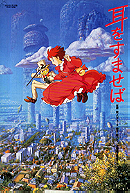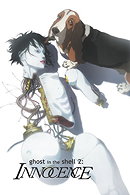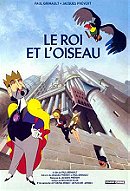Studio Ghibli
Sort by:
Showing 20 items
Decade:
Rating:
List Type:
Spirited Away (2001)
''Don't you see? It's called... Love.''
In the middle of her family's move to the suburbs, a sullen 10-year-old girl Chihiro/ Sen wanders into a world ruled by gods, witches, and monsters; where humans are changed into animals; and a bathhouse for these creatures.
Rumi Hiragi: Chihiro / Sen
''...Once you've met someone you never really forget them. It just takes a while for your memories to return...''
Hayao Miyazaki's animated masterpiece is obviously a very foreign Anime piece; not simply because it comes from another country i.e: Japan. There is an imagination at work that is so organic, so remote that it seems to be given birth from an individual's subconscious. Sen to Chihiro no kamikakushi(2001) from Studio Ghibli connects universally; speaking as it does in a language that suggests anything is possible and children (Plus imaginative adults) of all cultures will respond to it instinctively.
The soundtrack is also very effective in setting the mood in key areas of the story.
Sen to Chihiro no kamikakushi is trying to explain death in a simplistic yet secretive way to children; The creature/character No Face would be a likely candidate for that assumption.
Chihiro lets him in and does not fear him as with the adults fear of him; because she doesn't understand what he is. Interestingly, No Face travels on the ghost train and is, consequently, the only companion invited to stay with Granny when the friends decide to make their return journey.
Interestingly, the character No Face greatly resembles a silkworm. First, the film is Japanese and silkworms are important in Japanese culture. No face seems to have a white face and a mouth below it; Silkworms also have markings that look like facial features, and their mouths are below these indentations. Silkworms and No Face eat constantly and grow rapidly. At the end of the movie, No Face goes with Sen to visit Zeniba. No Face stays with Zeniba spinning silk which symbolizes the importance of the material and the creature. Miyazaki has created a perfect representation of the silkworm and an iconic character in the shape of No Face.
Personal favourite sequences included are the battle against No Face as Chihiro fends him away; by simply using a medicine/cure she was given and teaching him the importance of friendship. Also, revealing whom Haku really is and showing such loyalty to the one you love is a subtle touch; portraying the value of the emotional bond.
Lin: What's going on here?
Kamaji: Something you wouldn't recognize. It's called love.
The moral of this epic story is that sometimes perhaps, you need to mature and learn that you can't rely on someone else to save you.
It teaches us we must also value Friendship and loyalty.
Sen to Chihiro no kamikakushi is a fantastic animation from Studio Ghibli's Miyazaki; with beautiful music, charming characters, a storyline that sucks you in with art and imagination; beyond possibility and comparison.
First anime film to be nominated for (and win) an Academy Award. It also has the longest runtime of any other film nominated or winning in that category (125 minutes).
Also of note, the flexible light creation that jumps around and leads to the house is a reference to Pixar's mascot, Luxo Jr. Miyazaki is a big fan of Pixar and wanted to show his admiration with this sequence. Many of his inspirations are given tribute by Miyazaki.
Triumphantly in 2003,Sen to Chihiro no kamikakushi won the Oscar Best Animated Feature for Hayao Miyazaki; although Miyazaki was not present at the Awards ceremony, he definitely, like his Award winning piece, was there in spirit.
Simply put; a must see for any Anime fan, any fan of Ghibli studios; a story able to be enjoyed by children and adults alike. Sen to Chihiro no kamikakushi, or Spirited Away for Western audiences will leave you breathless and satisfied. It will capture your imagination and leave you spellbound.
Lexi's rating:


Grave of the Fireflies (1988)
''Why must fireflies die so young?''
A tragic film covering a young boy and his little sister's struggle to survive in Japan during World War II.
Tsutomu Tatsumi: Seita
Ayano Shiraishi: Setsuko
''September 21, 1945… that was the night I died''
With those words starts director Isao Takahata's most famous film, Grave of the Fireflies(Hotaru no haka, 1988). Quite differently to his long time friend and colleague legendary Hayao Miyazaki, Takahata prefers to leave fantasy elements in his films to a bare minimum. This is the way Takahata amazes viewers and audiences. If Miyazaki's fantastic visions from Spirited Away for example, make our jaws drop to floor with amazement, Takahata's close to reality stories touch us deeply by hitting our emotions. Grave of the Fireflies certainly does that masterly; being one of the few films that has managed to move me to tears.
The film, based on a novel by Akiyuki Nosaka, tells the story of a young boy named Seita, who with his little sister Setsuko, lives in the 1940's Japan, during the World War II. After losing their mother during a bombing, Seita does everything in his power to create an illusion for Setsuko that things are fine and there is nothing to worry about. The film has been often blamed of being too depressing and having a sad conclusion, but I think it's the opposite. Of course this certainly is not the kind of film to make you smile, but it is already revealed in the beginning that both brother and sister will die. So when we reach the end of the movie; with an image of them as spirits, sitting on a bench looking happy and healthy, with a modern day city around them, this is actually a happy ending after all the suffering they went through.
It's very hard to say exactly why this film should deserve full stars from me. It just does. It's full of little beautiful scenes that instantly have an effect on you, accompanied by Michio Mamiya's peaceful music. Maybe the fact that it can make me wonder why it is so good is the proof enough to make it a masterpiece. And that is what "Grave of the Fireflies" is; a masterpiece. One of the most amazing films from Studio Ghibli and Isao Takahata's most famous film. And definitely the ultimate proof that animations can be used for other than children's stories.
It's hard to watch Fireflies and feel positive at all; the death and loss is too much for a number of people to fathom. However upon my own reflection; the movie is one of the greatest studies into loss, love and tragedy ever, which will stay with you and compel you to take a second look at anime. For Anime is not simply just kiddie cartoons; it is simply another form of presenting a story in a different format.
Initially distributed with Tonari no Totoro(1988) because it was the only way that Miyazaki could have been able to make his Totoro. The reason being that the original film pitch for that film was rejected, so they pitched a double feature with Isao Takahata's Grave of the Fireflies, and the project was eventually backed financially by the original writer of the book on which Grave is based. It often was overlooked as a film because whenever Totoro was screened first, people were left happy and did not wish to be saddened by Grave afterward.
Interestingly, in South Korea, the release of the movie at the time was postponed indefinitely because of the concern that the movie somewhat justified Japan's role in World War II.
Again, you realize immediately this isn't a fantasy piece like Spirited Away but one of reality; which ends up being just as genius and just as compelling to watch. Isao Takahata has crafted a tale that also has historical significance; in the sense it displays the sense of hopelessness and desperation in Japan at the time and especially near the end of the second Wold War. A nation that could not support itself; where the rich has always stayed rich and the poor become poorer; ending with a divide that bears similarities to Spielberg's Empire of the Sun. The reality of Hotaru no haka cannot be stressed enough, the struggle mesmerizingly significant. Propels Anime, lifting it to new dizzying heights of storytelling.
Lexi's rating:


My Neighbor Totoro (1988)
''I bet you're Totoro.''
When two girls move to the country to be near their ailing mother, they have adventures with the wonderous forest spirits who live nearby.
Noriko Hidaka: Satsuki
Tonari no Totoro(My Neighbour Totorro)(1988) is probably the film that introduced many western audiences to the work of esteemed Japanese animator/director Hayao Miyazaki and his celebrated production house Studio Ghibli.
The decision to re-release all of the Miyazaki/Studio Ghibli productions as a collection of re-mastered DVD editions, including everything from his Lupin III instalment The Castle of Cagliostro to the more recent epic fantasy adventure, Howl's Moving Castle(2004) is a blessing.
Similarly to almost everything that Miyazaki has been involved with before; the piece offers us a series of intricate story lines, breathtaking visuals, memorable characters and a general approach to bold, imaginative, unique and utterly compelling family entertainment that will almost certainly appeal to anyone, at any age. My Neighbour Totoro remains, perhaps, the definitive Studio Ghibli production; Miyazaki here perfecting the visual style that would subsequently become his signature move, as well as developing variations of thematic devices that would be further explored in later projects Kiki's Delivery Service, Porco Rosso and of course Spirited Away.
The story takes place in the rural Japan of the 1950's, where two young girls and their father move into an old house near the forest in an attempt to distract the girls from the absence of their mother; whom is recovering from tuberculosis in a nearby convalescence home. Whilst exploring the forest, the two girls discover a family of forest spirits, the biggest of which they christened Totoro(a mispronunciation of tororu, the Japanese word for troll); whom allows the two girls to partake in their nightly adventures. With the film, Miyazaki and his team create a depiction of the perfect summer and the power of imagination, as they use the two children to act as a representation for the audience. Mei, the younger of the two sisters, comes to represent the youngsters within the audience, as she approaches the Totoro characters with wide eyes and enthusiasm and generally accepts each of their adventures to be a continuation of her imagined child-like sense of fabrication. Satsuki, the older of the two girls, straddles the line between childhood and pre-teen adolescence. Her character is often more cynical and level-headed than her younger sister, and therefore she is the perfect representation for an adult audience who may need to put aside their own sense of scepticism when approaching a film that is so shameless magical.
The story is fantastical, with Miyazaki allowing the action to unfold gently; bringing the girls (and us the audience) into the world of Totoro slowly.
The introductions of the soot spirits and the mythical king of the forest doesn't seem too unestablished when placed into a tale that evokes such plausible and believable depictions of reality(as with all the films of Studio Ghibli; Totoro has a keen obsessive attention to detail; with the texture of the locations and the use of light and shadow drawing you further and further into this world). The atmosphere throughout is perfect, whilst the characters (both in design and portrayal) are exquisite, with the two young girls setting the template for Miyazaki's aforementioned later films, Kiki's Delivery Service and Spirited Away, whilst the design of the mythical Totoro would become an important piece of iconography within Japanese animation (he's the chief mascot, as the Studio Ghibli logo, and is available in a range of plush-toy figurines).
The majority of Miyazaki's work explore deeper themes lurking beneath the surface of the story... Here, it is the idea of childhood and imagination being worn down by the creeping approach of adolescence. It has also been seen as a metaphorical study; with the relationship between the girls and Totoro being an imagined one in order to take their minds off the temporary loss of their mother relating to their concerns over her health. Whether or not you choose to interpret the story on such a level is entirely a personal venture, with the film working just fine as a lovely piece of family entertainment, with a warm and ultimately uplifting story being elevated by that gorgeous design/animation, the larger than life characters, and the story.
Tonari no Totoro is an exceptional film... one that has the power to entrance children and adults alike; with its evocative story, memorable characters and study of life and imagination. If you've never seen a Hayao Miyazaki film before, then this is a great place to start, and is really an essential piece of art alongside Spirited Away, and Howl's Moving Castle.
Only qualms would be the ending of it all but only because we wanted more; another masterpiece from Hayao Miyazaki.
''To-to-ro? You're Totoro!.''
Lexi's rating:


Princess Mononoke (1997)
''You cannot change fate. However, you can rise to meet it, if you so choose.''
On a journey to find the cure for a Tatarigami's curse, Ashitaka finds himself in the middle of a war between the forest and Tataraba, a mining colony. In this quest he also meets San, the Mononoke Hime.
Yôji Matsuda: Ashitaka
Mononoke Hime(1997)Princess Mononoke is quite simply not just a Japanese animation; It is however a phenomenon. During it's box office run in Japan 1997 it didn't only become the highest grossing Japanese film of the year, but the highest grossing Japanese film...ever to be released.
Mononoke Hime takes place in 15th century Japan and opens with a warrior named Ashitaka in fierce battle with a Tatari Gama (a huge boar with worms covering it's body). Ashitaka kills the demon and successfully defends his village from it, but in the battle he is touched by the gigantic monster on his arm; leaving a dark scar as a reminder. The village doctor tells Ashitaka that it is a curse and is slowly killing him. Convinced that there must be a cure, Ashitaka leaves the village never to return....Thus begins the epic story of Mononoke Hime.
So what makes this film so amazing? First of all, the obvious: the writer/director and animator: Hayao Miyazaki. Known for revolutionizing the animation world with his non-conventional children's films (Kiki's Delivery Service, My Neighbor Totoro, Spirited Away), this is his most mature film, and I don't just mean in terms of content. Yes, this film is violent, deep and not for the squeamish but it's beside the point. The story is dark and deeply personal. Miyazaki had stated that after all his more family-friendly films were out, this was the film he felt he just had to make. There is an air of deep seriousness that comes with this film that is hard to miss.
Please remember this, most of all: Miyazaki's films are not strictly Anime.
Miyazaki is completely different in style, animation, texture and story. The one thing that angers more than anything are the people whom hurl abuse at this project because they do not like Anime. A reminder to everyone who hasn't seen this film is to take this into account.
Miyazaki's paints a world like no one has ever seen, and always beautiful and fascinating. What really brings his films to life is the resonating music. Half of what makes his films so beautiful is the score of Joe Hisaishi; perhaps one of the most gifted musicians in films around. His music is intriguing, mysterious and impossible to ignore. With films like this, I get to thinking his music was made for Miyazaki, and Miyazaki's films were made for Hisaishi. They balance each other perfectly and mirror each other in harmonic art.
Visually it's got so much going on to practically experience the abstractions that Hayao Miyazaki folds up into the rest of the story. The story itself trails along with the best of epic fantasy, with this crucial, earth-shattering quest that works on that level of action-adventure; as well as the mythological side of things. Some have stated that it is a piece of complex ideology in structure and storytelling; bordering on confusing and puzzling bewilderment. I would disagree, although I can see what they mean; you have to pay closer attention. On a more profound level, if one could call it such, it's really not hard to follow.
The protagonist of the film, is the type of tragic hero, though with one clear sight amid the chaos in his mind - peace. He is cursed by a sort of worm resembling jelly demon that runs amock in the darker recesses of the world. He searches for something to rid him of his scars while on the human side at some points (mostly dominated by the women impressed- or against- his skills); and with those of the wolves on the other side. The title character is part of the latter, though also human, bringing a little more of the underlying symbolism with a character. Then there are also the boars ready to destroy the humans; even tat the expense of their lives. Amid the battles that rage on, leading to the significance of a certain Deer God as the centerpiece of the balance of the forests and civilizations; not too much is made explicit. At the same time, the side taken by the cursed hero is even questioned by one character; with that part connected among the others, the story elevates what could have been a kind of smothering over-symbolic representation into what is necessary and spectacular about the whole story. Quite simply, another masterpiece of Hayao Miyazaki's Studio Ghibli; that echoes a sensational message about our treatment of animals and the Environment.
''In ancient times, the land lay covered in forests, where, from ages long past, dwelt the spirits of the gods. Back then, man and beast lived in harmony, but as time went by, most of the great forests were destroyed.''
Lexi's rating:


''A girl just fell from the sky.''
A young boy and a girl with a magic crystal must race against pirates and foreign agents in a search for a legendary floating castle.
James Van Der Beek: Pazu
Hayao Miyazaki cream of the animation world with his deliciously successfully epics; maker and writer of Princess Mononoke and Spirited Away, establishing a reputation of international recognition. But, long before he made epics with environmental messages and films with magical resonance and significance, he made this; Tenkû no shiro Rapyuta(1986), better known as Castle in the Sky.
The storyline is simple; a boy becomes friend with a girl whom has fallen from the sky, but landed safely thanks to a magic medallion she possesses. They soon end up being chased by pirates and agents trying to claim her mystical medallion, as this is artifact gains access to a floating castle known as Laputa; This castle coincidently(or indeed destiny) is the boys dream location of visiting. So, with his passion in mind, the boy and girl eventually team up with the pirates, set off to find this castle, although they have been followed by the agents who intend to steal its rare treasury.
With such a story that is never straightforward, there is more than just a fantastic script that makes this an all-time favourite animated film. Why? Indeed many will raise this question. For starters, there are action-packed sequences; like the chase sequence through the mines, executed with great suspense as well as being entertaining to the audience. Also great comedic moments; such as the men flexing their muscles before they start a chaotic fight in the street. Trust me, with the character designs for these guys, and the character animation done well to exploit their expressions; it is only just one example of Miyazaki's masterpiece's charm and sophistication. Development of the main characters is executed flawlessly; we view a relationship between the boy and the girl throughout this film. This is something you do not see that much in animated cinema; as such western animated projects spoil this progression tragically.
Dubbed in 1999, Laputa unfairly did not receive a home video release until four years later due to Spirited Away winning an Academy Award for Best Animated Film. During that time, it would be shown at the occasional film festival, selling out with little conversation about it. Despite limited success, Disney's official explanation for the delay was that Studio Ghibli wanted to avoid reverse-importation of the film in Japan and lose respective sales. However, by 2003, Laputa had long made its money back in dvd sales in Japan; fueling fire to the long-held fan speculation that the company purchased the Ghibli library for the purpose of sabotaging its potential success in the U.S.
Also interesting to know that the weaponry and mechanical settings in Laputa is a mixture of British and German designs. Miyazaki is a fan of German weaponry (he has manga works like The Return of Hans and Otto Carius - both about WWII German tank crews), so soldier's uniform, medals, and grenades(Stielhandgranate, the famous "potato masher" in WWII) are modeled after German design, not to mention the gigantic battle zeppelin "Goliath." However, since the town of Slag Ravine was modeled after a mining town in Wales, British-styled civilian clothing and British weapons such as Lee-Enfield SMLE Mk. III rifle (soldiers) and Webley top-break revolver (Muska and his agents) appeared frequently in the film.
The robots too in the film are inspired by another source; the ones being featured in the Fleischer version of Superman.
So, for those whom think Hayao Miyazaki is just another celebrated animation director for the current climate of animated cinema in recent years, they better stop and retrace their thoughts again. This is because he has long been successfully establishing his trademarks; such as the focus on children and his indulgent passion for flight, brilliantly pursued before he made his truly deserved impact on the international table. Castle in the Sky shows Miyazaki at his best once again, which is a standard he has been developing ever since, entertaining and fascinating millions worldwide along the way.
''Take root in the ground, live in harmony with the wind, plant your seeds in the Winter, and rejoice with the birds in the coming of Spring.''
Lexi's rating:


''It's all so familiar yet I know I've never been here before. I feel so at home.''
When an unconfident young woman is cursed with an old body by a spiteful witch, her only chance of breaking the spell lies with a self-indulgent yet insecure young wizard and his companions in his legged, walking home.
Christian Bale: Howl
Hauru no ugoku shiro(2004), known to us as Howl's Moving Castle was greeted with numerous reviews not equaling those that Spirited Away received, which is understandable yet undeserving. Miyazaki tells his tale outside the parameters of Western storyline structure. Taking liberties with every aspect, telling it how he wants it to be told, and at first it is a little strange because of the failure recognitive of classic plot points we are so used to seeing; critics have marked it as below par Miyazaki on account of this. I find this ridiculous, and so does Miyazaki. In an interview Miyazaki said "The fact that you would expect a story to be told a certain way is ridiculous." I quite agree Mr. Miyazaki. The film is among his best, abundant in rich imagination and delightful characters set in a world of fantastical sights and sounds, Where everyone has a fly-machine(Miyazaki is an aviation fanatic), where wizards walk among the common folk.
The film was not released in the United Kingdom until 23 September 2005, yet Director Hayao Miyazaki personally traveled to England in the summer of 2004 to give a private showing of the film to Diana Wynne Jones, a very respectful act. Dianne Wynne Jones, the writer of the book Howls Moving Castle; upon which this film is based combines the essence of the story Jones wrote with the style and art of Miyazaki.
The premise and plot; Young Sophie Hatter is cursed by the Witch of the Waste, and turns into an old hag. Ashamed of how she looks, she flees into the hills where a moving castle roams the hills. This castle known to belong to the young and handsome wizard Howl; whom has a bad reputation. Within the castle, Sophie befriends the fire demon Calcifer who promises to help her become young again. One catch, she must help Calcifer to be free of Howl, and Calcifer cannot tell her how. However, Sophie agrees to stay and try and find out about the contract threw other ways. Still, Howl can see that Sophie is under a spell (like Calcifer can) and falls in love with her for who she is and not what she looks like. Sophie manages to bring life to the moving castle, and help Howl to face his former tutor, Madam Sulimen.
Howl's Moving Castle is riddled with classic Miyazaki: strong women characters, open landscapes, flying machines that are so fantastical you don't care whether the make sense or not, and the horridness of war. These add strength to the love story of Howl and Sofi. Miyazaki uses his wonderful power to take classic, almost mythological and fantasy laden story of Dianne Wynne Jones we all know, and archetypal characters and make them a vision of his own making. He does this with a host of wonderful characters. More strange creatures play prominent role here then any other Miyazaki film.
The film even sometimes surpasses Spirited Away in sheer scope and majesty. There is Calcifer, the wonderfully comic fire demon, on Turniphead; the Scarecrow that leads Sofi to Howl's magical moving castle. The castle itself is one reason to see the film. Miyazaki succeeds in giving the castle life and personality. It lumbers along on its thin chicken-like legs, every atom of it's being pushing, pulling, pumping and gyrating in perfect synchronization.
What is truly mesmerizing about Howl's Moving Castle is how it reaches the imagination and fantasy that Spirited Away had; while with the subtlety and moral splicing of Princess Mononoke while standing on its own in perfectly unique way. There have been complaints of lack of proper character development, but like the point before this is no ordinary story. The characters are thrust into a world they do not know, and there they must adapt, and live outside what they have known all their lives. It is not a story of who they were, but what they have become, or what they must become in order to meet their existences purpose. It does not dwell on the past, and gets into the thick of the story; not pausing for flashback explanations we have come to know. It is like nothing I have ever seen before.
To summarize the whole experience : the American voice casting is brilliant, possibly the best assemble ever on a Miyazaki film, which is saying quite alot. Billy Crystal, Christian Bale(Upon seeing Miyazaki'sSpirited Away, Christian Bale immediately agreed to play any role in this film), Lauren Bacall, Jean Simmons and others provide perfect voice overs. Please, if you enjoy Miyazaki and you have not seen this yet, I recommend you do as soon as possible for you will of course fall in love with it. To summarize
Hayao Miyazaki's achievement with making a visionary film from a book should be summed up by the writer. A fitting way to end my review and sum up the film would be to quote Diana Wynne Jones thoughts on the film, "It's fantastic. No, I have no input - I write books, not films. Yes it will be different from the book; in fact it's likely to be very different, but that's as it should be. It will still be a fantastic film." Take her word for it and mine; It IS a fantastic film.
''You who swallowed a falling star, o' heartless man, your heart shall soon be mine. That can't be good for the table.''
Lexi's rating:


''We each need to find our own inspiration, Kiki. Sometimes it's not easy.''
A young witch, on her mandatory year of independent life, finds fitting into a new community difficult while she supports herself by running an air courier service.
Kirsten Dunst:Kiki
Majo no takkyûbin(1989) known as Kiki's Delivery Service features such a character in Kiki, a thirteen year old witch whom is made to leave home and find a new city in which to hone her skills.
The trials and liberations of independence await Kiki in the town she chooses to live. But for the most part Kiki seems to be able to find a generous benefactor to help her overcome obstacles without resorting to her natural powers. Her helpfulness earns her a lodging at a bakery where Kiki quickly resolves to start a delivery service. When she almost botches her first errand she relies on the kindness of a cabin dwelling artist who has found the toy black cat Kiki had dropped. And later a sleepy eyed St Bernard helps her exchange it with her black cat Jiji, who had been pretending to be a toy in the recipient's house. Because Kiki meets with friendliness from everyone; the film avoids confronting the lurking menace the big town would normally pose for a thirteen year old girl. Rather, the unimaginative conclusion of the film seems to be that friendliness always benefits it's patrons.
After Kiki promises a boy she meets to attend a party with him, she spends her entire day helping an old woman prepare a herring pie for her granddaughter and misses the appointment. This is around the time Kiki begins to lose her magical powers. But this is a rare reminder that Kiki is supposed to be a training witch, and the film never explains how Kiki loses her magical powers and how she subsequently regains them at a conveniently helpful interval in the story.
Due to Hayao Miyazaki's spirited direction the film rarely loses its magical spark. Nonetheless; also the writer of the film, Miyazaki takes many thoughtful detours from the fundamental themes underlying the story. After seeing this film, a viewer may still wonder why those people seemed to be so undisturbed by the sight of an adolescent witch zooming across their town on a broomstick. One may also ask why Kiki decides to start a delivery service instead of sticking to her avowed mission to train to be a witch. Unfortunately, Kiki's Delivery Service leaves these and many more questions unanswered. Fortunately we can fill in the blanks with our imaginations.
What sets Kiki's Delivery Service apart from many of Miyazaki's other works is the personal, rather than epic, nature of the story. It wonderfully captures the daily life of an aspiring 13-year-old girl moving into the life of a bustling town. While there is plenty to please the thrill-seeking adventurous spirit, the film's real beauty lies in its ability to portray the more introverted aspects of life. Most Western animated cinema centers around loud, pop-influenced music and a bad-guy-fighting action-oriented plot, but Kiki's Delivery Service has a charming and understated musical score, and lacks a traditional antagonist. Life isn't all excitement and fighting bad guys; something that this film seems to get across more so than any Disney, Pixar, Fox, or other Western animated film I've ever seen. In fact, the doldrums of life are what form the heart of this film.
Majo no takkyûbin is a masterpiece, and Kiki's search for the heart within herself is a tale that adults may appreciate more than their children. Indeed, Kiki is one of the most appealing characters that Miyazaki ever brought to life, which is certainly saying something. One of Miyazaki's great talents is in never be belittling his audience, and with this fantastic story he proves this point once again.
''Well, well, well... hello kitty.''
Lexi's rating:


Beautiful, imaginative Anime from the great Hayao Miyazaki, and Studio Ghibli.
Isao Takahata was behind Hotaru no haka(Grave of the Fireflies).
Ghost in a Shell-Innocence is a co-production from Ghibli.
King and the Mockingbird, The Like the Clouds, Like the Wind & Marco are movies related to Ghibli/Staff.
Isao Takahata was behind Hotaru no haka(Grave of the Fireflies).
Ghost in a Shell-Innocence is a co-production from Ghibli.
King and the Mockingbird, The Like the Clouds, Like the Wind & Marco are movies related to Ghibli/Staff.
 Login
Login
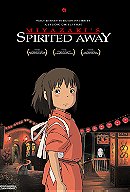
 4700
4700
 8.4
8.4
 8.6
8.6
